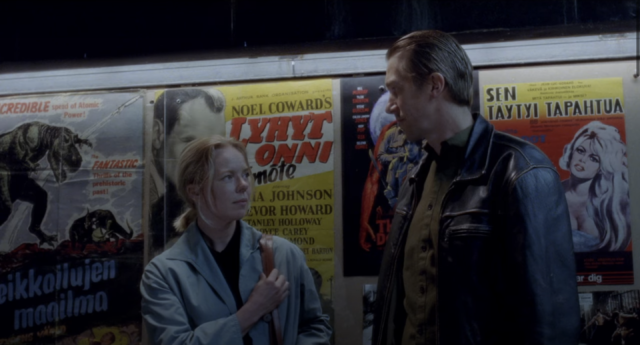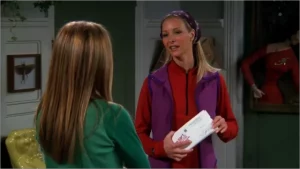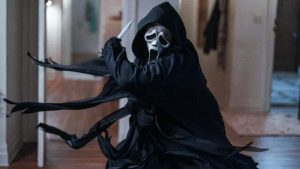
The post Fallen Leaves: Harmony of Contrasts, by Scott Nye appeared first on Battleship Pretension.
Despite saying at the time of its release that The Other Side of Hope would be his final feature, 66-year-old Finnish filmmaker Aki Kaurismaki is back with a new film on old themes – middle-aged people on the margins of society forming unexpected bonds. Here, Ansa (Alma Pöysti), a supermarket worker, is fired for stealing food the store was going to throw out; nearby, Holappa (Jussi Vatanen), an alcoholic, is barely holding onto his construction job. They meet, take a liking to one another, random misfortune forces them apart, determination brings them back together, and the cycle repeats at least once more.
Love takes determination at any age, but as we get older, the things that govern our lives – not least of all our own routines and preferences – feel more and more like immovable objects, and any effort to push past them will result in some karmic force swatting away the new in favor of the familiar. Kaurismaki thrives in circumstance and obstacles, from anodyne accidents like a lost phone number to massive upheavals like an arrest. For people like Ansa and Holappa, life is less a series of choices than things happening to them.
This is reflected in a more global context through radio news reports about the war in Ukraine. Russia is a neighbor to Finland and their invasion has had profound effects for the region. It’s not a foregrounded theme the way immigration was in Kaurismaki’s last two films, Le Havre and The Other Side of Hope. None of the characters really talk about it. Their own socio-political circumstances are plenty trying on their own. But it’s always there in the background, humming away.
The film otherwise seems almost outside of time, its technology frozen in the late 20th century, with the artifacts of earlier times (tube radios and televisions, landline cordless phones) at war with newer, hip coffee shops, modern police cars, and the unexpected appearance of Jim Jarmusch’s 2019 film The Dead Don’t Die. Kaurismaki’s visual style has not changed much over the course of his career, casting his interiors in heavily-emphasized shadows cast from a strongly-defined but ambiguous light source, and vibrant, but slightly muted, colors that boldly delineate the clothing from the sets.
Pöysti and Vatanen make an interesting visual pair, her with a round face and narrow eyes, he with a lanky, almost gaunt build and wide eyes. There is a lot of harmony within Kaurismaki’s contrasts – his characters’ circumstances are ripped from everyday life, yet they live in a world of unnatural coincidence and colorful placidity. The audience is constantly treated to crisp and distinctive individuals who spout nonsense that verges on wisdom, and vice-versa. They live at the edges of existence in dire straits (when Ansa and Holappa meet, he correctly guesses she hasn’t eaten in too long), but are not desperate. They are resolute, proud, and calm in the face of adversity. Or too stubborn in the face of change. Or too desperate in the face of loneliness. They are volatile, raw people in a world that will not yield, but which might, occasionally, if you look for it, comfort.
The post Fallen Leaves: Harmony of Contrasts, by Scott Nye first appeared on Battleship Pretension.
The post Fallen Leaves: Harmony of Contrasts, by Scott Nye appeared first on Battleship Pretension.




